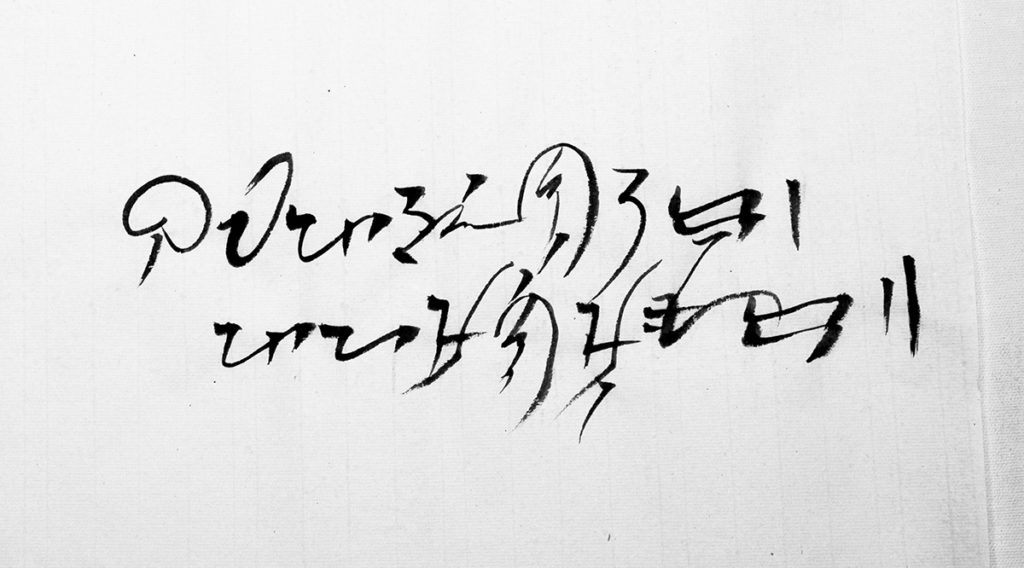Baybayin Calligraphy

Two Ancient Filipino Poems
Buwáng panginoón kó, payamánin mó akó.
“My Moon Lord,
make me rich.”
Lakapáti, pakánin mó yaríng alípin mó. Huwág mó póng gutúmin.
“Lakapati, feed
this servant of yours.
Do not let him starve.”
I found these two poems after reading Jean-Paul G. Potet’s “Baybayin: the Syllabic Alphabet of the Tagalogs” and Christian Cabuay’s “An Introduction to Baybayin.” What’s fascinating is that these are poems written before Philippines was the “Philippines” (before Spanish colonization)!
The “Moon Lord” and the rice-field fertility Goddess, “Lakapati” are references to ancient Filipino mythology. Some people may be familiar with the Hinilawod— a 30-hour long, oral epic poem from ancient Philippines.
These poems are also composed in heptasyllable lines. Seven syllable lines are a hallmark of other Filipino poetic forms such as the Tanaga or Ambahan.

Baybayin Script
According to Potet, a French linguist and Baybayin scholar, Baybayin was originally carved on bamboo and then rubbed with ash to make the letters stand out. He has collected extensive evidence that Filipinos wrote bottom to top as well as left to right. Here are some other high-yield notes about Baybayin:
- Baybayin is an ancient, pre-Spanish, Tagalog writing script from the 13th century.
- Baybayin is not an alphabet, it is a syllabic script. Notation units traditionally can only represent syllables with inherent vowels. “Kudlits” are added to the notation unit to denote vowel changes. For example, there are characters for “ba, be, bi, bo, bu” (ᜊᜊᜒᜊᜒᜊᜓᜊᜓ) but not “b.”
- There are only three vowels because the ancient Tagalogs did not distinguish between the pronunciations of i and e, or u and o until Western and Spanish words entered their language.
- Traditional Baybayin cannot show final consonants. For example, the letters n and k in a word like bundók (mountain) were omitted, so that it was spelled bu-do (ᜊᜓᜇᜓ).
- In 1621, Father Lopez created the cross “kudlit” ( + ) that cancels a vowel. Therefore, “b” without a vowel can be represented with a little cross (ᜊ᜔᜔᜔᜔). In the 1900s, Antoon Postma created the “pamudpó” which is another method of notation to cancel a vowel. “b” can be represented as ᜊ᜴.
- Traditionally, there are no “ch, f, j, q, sh, th, v, x, or z” sounds in Tagalog and thus no Baybayin equivalent. Modern Baybayin approximates those sounds (“j” = “ᜇᜒᜌ”; ie. “Joey” = di-yo-i = ᜇᜒᜌᜓᜁ)
- There is only one character for “da” and “ra.” Pronunciation depends on placement of the syllable within the word. In modern Filipino, when a “d” is between two vowels, it becomes an “r” as in the words dami (a multitude, ᜇᜋᜒ) and marami (many, ᜋᜍᜋᜒ).
*If you see only squares above where Baybayin script should be, you need to download a Baybayin font. Links below.
Baybayin Letters
Links
I’ll be studying more Baybayin and ink calligraphy. Until then, I also included some good links I’ve found:
-
- See more calligraphy and art on my Instagram: https://www.instagram.com/henryrdr/
- Amazing Baybayin resource by Paul Morrow at http://paulmorrow.ca/bayeng1.htm
- Fastest way to learn Baybayin (free online course): https://www.memrise.com/course/196548/beginning-baybayin/
- Baybayin keyboard for Mac: http://nordenx.blogspot.com/2012/05/baybayin-unicode-keyboard-layout.html
- Baybayin typefaces/fonts: http://paulmorrow.ca/fonts.htm
- An academic, linguistic book: Jean-Paul G. Potet’s “Baybayin: the Syllabic Alphabet of the Tagalogs”
- A layman’s 40-page intro to Baybayin: Christian Cabuay’s “An Introduction to Baybayin.”

Leave a Reply